One Of Australia's Most Dangerous And Untouched Regions Has Crocs Lurking Below
What if we told you that in Australia, you could visit a place the size of California that's home to under 40,000 people? A land where the waterfalls flow horizontally, and 19-foot-long, 1,000-pound crocodiles roam, looking for their next meal. An area where the rocks are 2 billion years old and the art dates back 17,000 years. Welcome to the Kimberley, one of Australia's most awe-inspiring, remote, and undeniably dangerous regions.
Covering the northern part of Western Australia (WA), the Kimberley's pristine wilderness is challenging to reach. The region's gateways, Derby and Kununurra, are much closer to the Northern Territory's far-flung capital, Darwin, than to WA's largest city, Perth. This remoteness adds to the Kimberley's risks. In addition to the crocs, tourists have to worry about box jellyfish and irukandji jellyfish, potentially lethal stingers that inhabit the region's coastline. The tides can sweep you off your feet, and the relentless sun beats down, bleaching the landscape.
But don't let the risks deter you. Traveling to the Kimberley is a once-in-a-lifetime opportunity, offering raw adventure and untamed nature. The whiff of danger in the air makes this region one of the world's most exciting vacation destinations.
Adventures in the Kimberley
In such a vast land, there's enough to keep visitors occupied for weeks. Top of many bucket lists is a (not-too-close-up) encounter with a saltwater crocodile (saltie). A boat trip on the Lower Ord River is one of the best ways to spot salties in their natural habitat, while a hike into stunning Windjana Gorge offers the opportunity to see freshwater crocs, the salties' less dangerous cousins. If you do want to get really close to a saltie, head to Darwin and seek out the "Cage of Death" — an attraction definitely not for the faint-hearted.
Seeing the Kimberley from above is another bucket list item for many visitors. A scenic flight over the Bungle Bungles reveals an otherworldly maze of black and orange striped domes that rise out of the plains. Horizontal Falls is equally jaw-dropping from the air — if you're feeling daring, you can then hop in a boat to experience the unique and powerful rapids.
Back on land, the Kimberley is home to one of Australia's most remote and dangerous roads, the Gibb River Road. This 410-mile bone-shaking route is an off-roader's dream. Highlights along the way include the rock-art-lined paths leading to craggy gorges, ochre cliffs, plunging waterfalls and serene freshwater swimming holes. You can dive deeper into Aboriginal culture by visiting more ancient rock art sites along the coast and in the northern reaches of the region. Try to get to the Munurru site, an 11-hour drive north of Broome, where you can discover the two major types of Kimberley rock art.
How to discover Australia's untouched region
Many visitors begin their Kimberley adventure in Broome, a laid-back tropical town on the west coast. Visiting Cable Beach and taking a camel ride along the sand is a must. Broome's rich history as a center of the pearling industry is worth exploring, too — take a tour of a pearl farm to learn more. Before setting out into the wild, stop in at Matso's Brewery to try its famous alcoholic ginger beer.
As for where to stay, the Kimberley offers accommodations for every type of traveler. Budget-conscious adventurers will love the ability to camp for free in many places and the many reasonably priced campgrounds. Deluxe properties abound in the Kimberley, too, meaning you don't have to rough it. Check out El Questro Homestead near Kununurra, or the Berkeley River Lodge, which is only reachable by air. Luxury cruises also ply the coast, calling at crashing waterfalls, untouched rock art sites and paradise islands. These accommodations offer a gentle introduction to the Kimberley, allowing you to flirt with danger rather than embrace it with open arms.
Have we sold you on visiting one of Australia's most croc-infested regions? If you're ready to book a trip, we recommend going in winter, between June and August, when the skies are blue, the sun shines, and the temperatures are a little less sticky. Consider combining a visit to the Kimberley with a stop in Darwin, which Samantha Brown thinks is the best Australian destination to visit in June.


